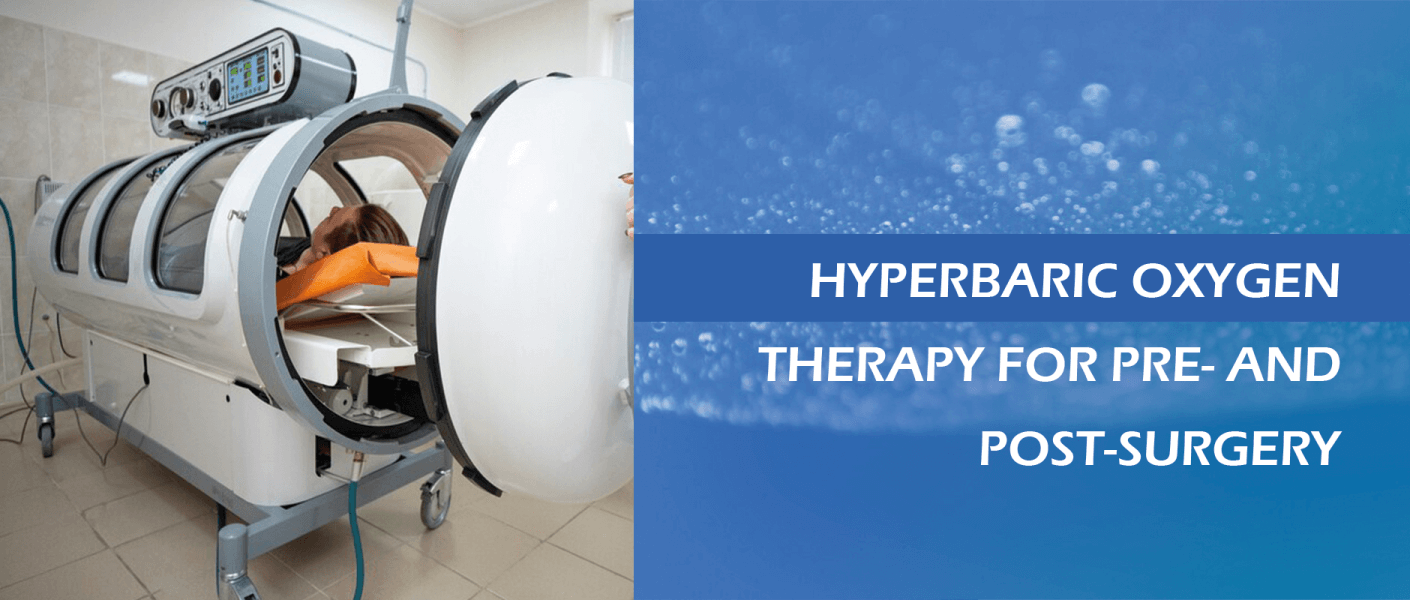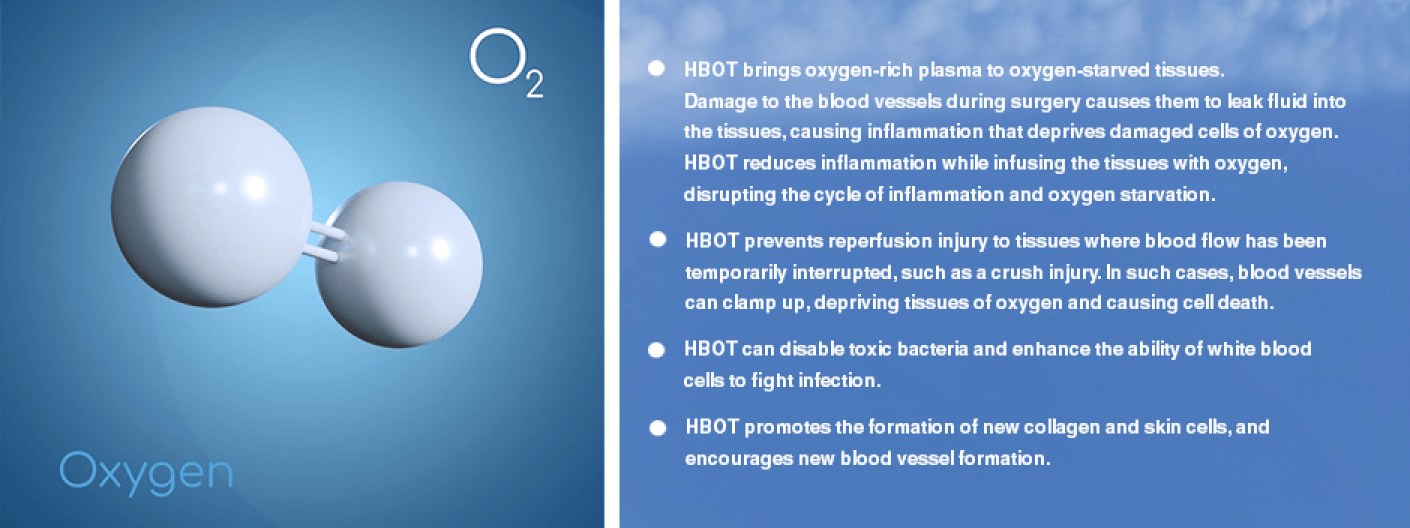
Any invasive surgical procedure comes with inherent risks, ranging from minor infections to major systemic reactions. To minimize risks and enhance surgical outcomes, doctors provide patients with preparatory guidelines such as pre-hab exercises, nutritional guidelines, and other advice to optimize the patient experience.
Hyperbaric oxygen therapy is often recommended to patients scheduled to undergo high-risk procedures like cardiac and brain surgeries, and its use as a preparatory and recovery tool is expanding as patients reap its benefits. Learn the mechanisms by which HBOT preconditions the body for invasive procedures, and how it can accommodate and accelerate healing, post-surgery.
Effect of Hyperbaric Oxygen on Cells and Systems
Oxygen is life, and cells deprived of oxygen cannot survive for more than a few minutes. For example, brain cells begin dying after just one minute of oxygen deprivation, and neurons suffer serious damage after just three minutes. After five minutes without oxygen, death is imminent.
Hyperbaric Oxygen Therapy (HBOT) works by dramatically increasing the amount of dissolved oxygen in the tissues, creating optimal conditions for tissue healing.
Benefits of HBOT include:
- Accelerated wound healing
- Formation of new blood vessels (angiogenesis)
- Reduced inflammation
- Enhanced mitochondrial function
- Escalated stem cell activity
- Protection of neural bodies
Benefits gained from HBOT at the cellular level add up to improved performance of systems throughout the body. When facing invasive surgery, patients with healthy cells and systems are less likely to have complications and more likely to quickly recover.
Conditions Where HBOT is Recommended for Pre-Surgery
When undergoing invasive surgical procedures, the body experiences a surgical stress response, a reaction thought to be the main underlying cause of postoperative complications. Surgical procedures place substantial demands on a patient’s hormonal, metabolic and immunological systems, and many patients go into surgery with those systems already compromised by lifestyle factors.
Two common post-surgery complications include incision site infections and anastomotic leaks – an occurrence where two tubular structures, such as blood vessels or intestine, that were sewn or stapled together do not seal together after surgery, allowing their contents to leak out and causing serious infections. Such complications can result in prolonged hospital stays, additional surgeries, and even death.
Hyperbaric oxygen therapy in the days leading up to surgery can help to shore up the body’s cells, making them more resilient and reducing the risk of dangerous postoperative complications.
Conditions where pre-surgical HBOT is recommended include:
- Cosmetic procedures (plastic surgery)
- Burns
- Cancer surgery
- Orthopedic procedures
- Diabetic wounds
- Skin grafts
- Radiation injuries
- Neuropathy
- Heart surgery
- Brain surgery
- Any procedures with a high risk of complications
While not all doctors recommend HBOT for all procedures, patients scheduled for surgery should consult with their surgeon to see if hyperbaric oxygen therapy could be beneficial, both before and after surgery.
How Hyperbaric Oxygen Promotes Post-Surgical Recovery
After surgery, the body is under great stress as it adapts to surgical changes made, and the immune system goes into overdrive to repair internal damage and heal the incision site. HBOT can help facilitate and accelerate the healing process via multiple mechanisms of action.

- HBOT brings oxygen-rich plasma to oxygen-starved tissues. Damage to the blood vessels during surgery causes them to leak fluid into the tissues, causing inflammation that deprives damaged cells of oxygen. HBOT reduces inflammation while infusing the tissues with oxygen, disrupting the cycle of inflammation and oxygen starvation.
- HBOT prevents reperfusion injury to tissues where blood flow has been temporarily interrupted, such as a crush injury. In such cases, blood vessels can clamp up, depriving tissues of oxygen and causing cell death.
- HBOT can disable toxic bacteria and enhance the ability of white blood cells to fight infection.
- HBOT promotes the formation of new collagen and skin cells, and encourages new blood vessel formation.
With HBOT, patients often have shorter recovery times, fewer complications, shorter hospital stays, and a faster return to normal daily living.
Get Hyperbaric Oxygen Therapy at Invita Wellness NYC
A growing body of research demonstrates that hyperbaric oxygen has multiple benefits for human health. In addition to reducing surgical risks and promoting post-op recovery, HBOT has been shown to bolster the immune system, reduce chronic systemic inflammation, and slow the aging process.
Inivita Wellness NYC now offers hyperbaric oxygen therapy as one of our many services to clients who want to optimize their health and quality of life. To ensure your safety, we carefully screen our clients for health issues prior to treatment. To enjoy the benefits of HBOT, contact Invita Wellness today!
To enjoy the benefits of HBOT
contact InVita Wellness today
Book Now
456 Broadway 2 Floor, New York, NY 10013, USA
Resources
Boet, Sylvain, et al. “Can preventive hyperbaric oxygen therapy optimise surgical outcome?: A systematic review of randomised controlled trials.” European Journal of Anaesthesiology EJA 37.8 (2020): 636-648.
Can preventive hyperbaric oxygen therapy optimise surgical outcome?: A systematic review of randomised controlled trials
Poyrazoglu, Yavuz, et al. “Effects of hyperbaric oxygen and preconditioning on wound healing in colonic anastomoses.” Journal of Investigative Surgery 28.4 (2015): 188-195.
https://www.researchgate.net/profile/Filiz-Sezen-Bircan/publication/278741883